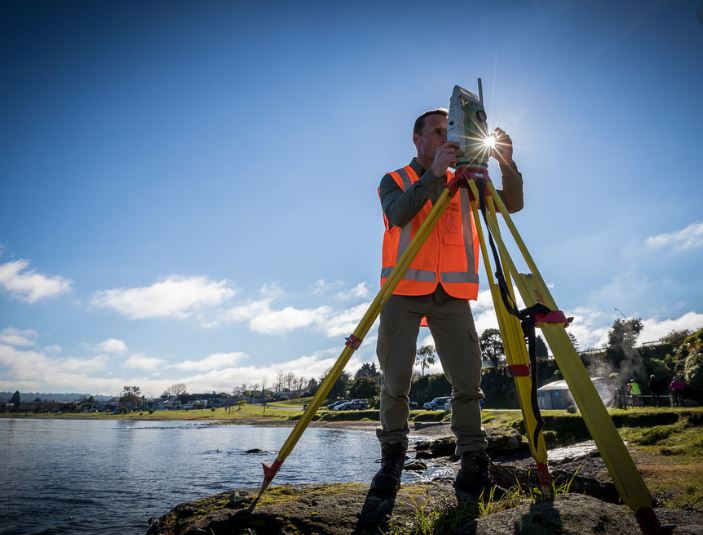Whether you oversee waterbodies in a community, on a golf course, a municipality, or a private property, you’ve likely noticed changes in your lake or pond year over year. It may seem cloudy or murkier, or perhaps it’s more prone to algae growth or flooding. Maybe your shoreline keeps receding, reducing the size (and value) of your property in the process. All of these signs point to severe sludge and sediment accumulation, which occurs naturally over decades. With very few solutions left to reverse this problem, professionals usually recommend dredging.
Stakeholders often cringe at the thought of a looming dredging project—it’s invasive, messy, and most of all, expensive. It can be extremely difficult to determine how much it will cost to dredge a pond without a professional evaluation and in-depth planning.
The most asked question when considering a project is “How much does pond dredging cost?” The answer to this question will depend on a number of variables unique to each property. Here, we break it all down to help you understand the many factors that make dredging so costly and the undeniable importance of preventative maintenance.

What Is Dredging?
Many lake and pond managers do not recognise the complex nature of their aquatic ecosystems. Our water bodies are constantly changing and in a sense, aging. Over the course of two to three decades, they begin filling in with sediment and debris due to both natural and man-made forces. This results in loss of depth and volume, flooding, nutrient loading and other concerns that further expedite the decline in aquatic health.
The term “dredging” may mean different things to different people but ultimately refers to the removal of sludge, sediment, detritus, or organic matter from the bottom of a waterbody. This management method is used to restore depth and volume, as well as remove excess nutrients and pollutants from the ecosystem.

How Do I Know If My Waterbody Needs Dredging?
Dredging projects can be expensive, unsightly and inconvenient. Because most stakeholders have little idea how much it will cost to dredge a pond—or that they need to dredge one at all—they don’t begin budgeting soon enough. Many stakeholders have zero funds available and must take out considerable loans or save for several more years, all the while watching the continued decline of their waterbody. This tends to be the case when action is not taken until problems have already passed the point of no return.
Here are a few signs your waterbody may need to be dredged:
- Flooding occurs during rainstorms
- Shoreline erosion and steep, crumbling banks
- The emergence of sediment islands
- The growth of trees and shrubs in the water
- Bottom sludge, cloudiness, and bad odours
- Chronic algae and weed issues
- No record of dredging in the last 20-30 years
These indicators suggest that it might be time for a professional evaluation.
Types of Dredging
There are multiple types of dredging equipment available to accommodate various properties, environmental restrictions, budgets, and waterbody types—each with their own benefits and challenges.

Mechanical Dredging
During mechanical dredging projects, the water is drained from the lake or pond and a long-reach excavator is used to remove the wet sludge. This style of dredging is impactful and allows full visibility while working around underwater drains and equipment.
Mechanical dredging also has its drawbacks. By draining all water, native plants and wildlife are displaced. Reestablishing aquatic habitats can increase overall project expenses.
Mechanical projects might be an appropriate solution for more rural properties but are much more intrusive and unsightly in community areas. Building ramps or removing landscaping, sidewalks, and other community infrastructure may be necessary to gain access to the waterbody. In some cases, a crane must be used to hoist equipment over buildings, trees, and obstacles. All of these considerations are built into final lake dredging costs.
Hydraulic Dredging
During the hydraulic dredging process (also referred to as liquid dredging), water and sludge/sediment is pumped to a dewatering bladder or filter system. The solids are retained and the clarified water is returned to the lake or pond.
Hydraulic dredging is an excellent solution for urban areas that are unable to accommodate large equipment on site. Dredging is less intrusive for populated areas and helps preserve the plants and wildlife present in the water.
However, the lack of visibility associated with hydraulic dredging makes navigating the base of the waterbody more difficult. It’s common to encounter stormwater equipment, drains, concrete buttresses, irrigation and sprinkler systems and other unexpected objects or infrastructure under the water, which can lead to potential damage, project delays, and increased expenses.
Budget Considerations
The benefits of dredging are clear, but many stakeholders do not understand the various considerations that go into a price estimate and may underestimate how early they should begin budgeting for these projects. How much does pond dredging cost? Here are some of the top factors:
Equipment, Overhead, & Safety Costs
Dredging projects are relatively labour-intensive, require trained personnel and sometimes specialist equipment. Uncovering large debris or plastic liners during the process can make restoration efforts more difficult. These and many other unpredictable events such as the weather may require pivoting and additional funds.
Quantification & Dewatering Costs
When planning a project, professionals start estimating lake dredging costs by determining how much material needs to be removed and what the material is made of. Measuring the level of build-up can be challenging, so dredging experts rely on sludge surveys to create a three-dimensional model of the waterbody that reveals depth, base contours and solids volumes.
Material composition is important because it guides the type of equipment used for the job. Sandy, gravelly materials dewater much faster than organic sludge. More liquid materials must be handled and disposed of differently than dense substances.
When dredged materials are deemed too watery, they may require dewatering prior to removal from the site adding additional costs to the project. Geotextile dewatering bags and specialised dewatering tanks contain the solids while letting the water escape back to the waterbody. This process can take anywhere from a few days to many months depending on material composition and how much was removed.

Lab Testing & Disposal Costs
Once the dewatering and drying process is complete, the materials are typically removed from the site for disposal. While this may seem like a straightforward process, complex regulations determine where, when, and how materials can be disposed of.
Before material disposal, laboratory tests must be conducted to identify the presence of metals and contaminants. Depending on the results, landfills may impose additional fees to dump the material. Environmental hazards are surprisingly common in lakes and ponds, particularly those near construction and urban development sites.
The presence of invasive plants or animal species can add additional challenges and increase the cost to dredge a pond. Depending on the situation, invasives may need to be managed before a dredging project begins, as well as thorough equipment and material inspections prior to disposal. This prevents spread into other ecosystems across the region.
Landfills will charge significantly higher rates if materials are too saturated with water. This means the longer that stakeholders dry out their materials, the more money they can save. Unfortunately, this can also mean that dredged materials must remain on-site for weeks to months, creating an eyesore, damaging grass and landscaping and releasing bad odours.
Depending on the nature of the dewatered material, it can sometimes be repurposed or disposed of on-site to cut disposal costs. Clients with available land may be able to transport materials to designated areas on their property without concern for drying.
Safety & Permitting Costs
No matter the method used, dredging is messy and can cause significant environmental stress by displacing native wildlife, interfering with the natural processes, and releasing hazardous materials from the soil. Reputable companies often consult with environmental consultants throughout the project to monitor and mitigate environmental risks, including the downstream impact.
Certain projects may require consents which can be particularly complicated and costly to obtain. Consents can also be revoked in the face of new weather conditions or project delays, further impacting the project budget.
How Proactive Management Can Cut Lake Dredging Costs
The end of a dredging project does not mean responsibilities are complete. It’s important to establish a plan that not only predicts future dredging needs but also prolongs them for as long as possible. Without proactive strategies in place, stakeholders may see their waterbody prematurely return to its prior condition.
Professionals utilise many cost-effective tools, technologies, and services to monitor and support healthy, balanced waterbodies. These are most effective when used as part of a long-term management approach. When working on an annual basis, professionals can strategically plan and implement the right solutions at the appropriate times of the year—and make adjustments as internal or external conditions change. In addition to prolonging the need for dredging, these and other annual management services help reduce long-term expenses:
Sludge Surveys
Professionals rely on survey mapping data during the planning stage of a dredging project, but mapping is most beneficial when used as a proactive tool. When conducted every 1-3 years, experts can carefully monitor sediment accumulation and implement preventative solutions while the build-up is manageable. Most importantly, the data can be used to calculate when the next dredging project may need to take place and inform the budgeting process.

Biological Augmentation
During this process, bacteria and biological stimulants are applied to the lake or pond. These beneficial organisms feed on nutrient-rich organic matter helping to eliminate sludge naturally. This process can maintain depth and healthy water quality conditions.

Shoreline Restoration
Lake and pond shorelines erode and become unstable without proper maintenance. The resulting sedimentation contributes to sludge build-up. Introducing beneficial buffer plants along the edge can help keep soil in place and slow runoff that degrades the shoreline during rainstorms. Waterbodies with significant shoreline damage may require complete restoration.
Bioengineered shoreline technologies like SOX Erosion Solutions help reshape and anchor the eroded soil to the bank for improved stability and aesthetic value. In some cases, materials removed during hydro-raking or dredging projects can be used to rebuild the shoreline. This is a great way to dewater and repurpose dredged material.

Protect Your Investment
It’s clear that all waterbodies will need to be dredged at some point, but the lack of clarity around pricing can make it a frustrating investment in your property. With so many factors at play, it can be difficult to even get a ballpark estimate. Once planning begins, stakeholders must make many decisions that can affect the entire project and overall cost to dredge a pond.
No matter the current state of your waterbody, it’s important to consult with a reputable company that empowers you with the knowledge to make informed decisions throughout the process, from budgeting to execution to post-project maintenance.
How much does pond dredging cost? Contact us below to begin your assessment.
0800PARKLINK
